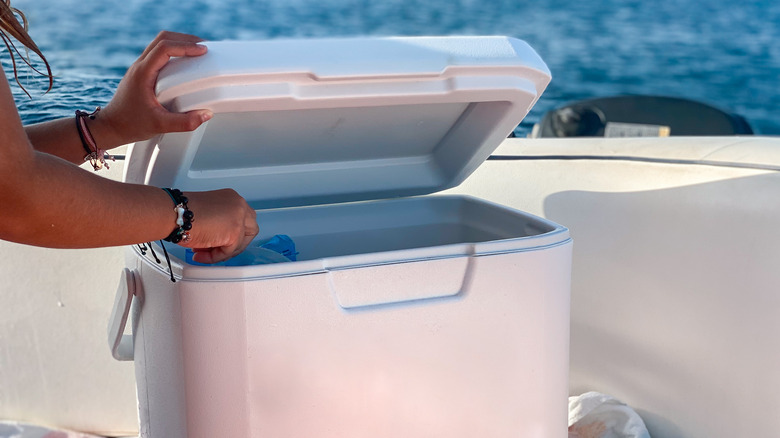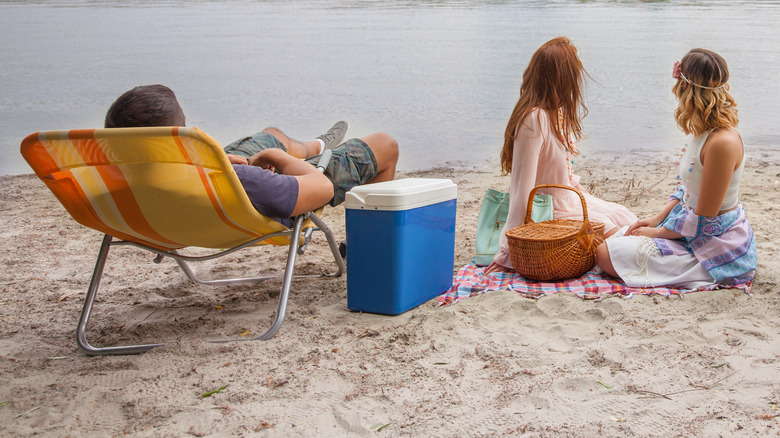Does The Color Of Your Insulated Cooler Truly Matter? Here's What You Should Know
Buyers looking for a new cooler for the summer months have a long list of decisions to make. They'll need to pick the right size for their needs, choose between an airless or foam-insulated cooler, and decide whether to stick with a budget option or cough up the cash for a cooler from a high-end brand. Picking the color of the cooler can seem like an afterthought, although in some situations, it might be worth being picky about exactly which color you choose.
In general, some colors absorb more heat than others — it's why wearing all black clothing on a sunny day will often get you hot and bothered more quickly than wearing light colors. Following that logic, darker-colored coolers should heat up faster than lighter-colored ones. Thus, a white or light-colored cooler should be the best bet if you're looking for maximum ice retention on a hot day.
A comparison by YouTube channel Outdoor Empire put this theory to the test and concluded that, in full sunlight, a white cooler will indeed retain ice longer than a black cooler. The test also included a blue cooler, which retained ice for longer than the black cooler but for a shorter time than the white cooler. However, there was no significant difference between colors when the coolers were left in the shade.
Tests show that white coolers have an advantage
The Outdoor Empire test involved leaving three coolers outside for a week in a south-facing position during the summer months. All three were made by the same manufacturer, and each received the same amount of sunlight over the course of each day. The test measured the lid temperature, the internal air temperature, and the temperature of a water bottle that was submerged in ice inside each cooler.
The lid temperature figures were the most drastically different, with the black cooler lid reaching far higher temperatures (144 degrees Fahrenheit) than the white cooler (97 degrees Fahrenheit). The blue cooler's lid temperature hovered between the black and white coolers, although it was closer to the black cooler. The internal air temperature measurements produced similar results, with the white cooler sporting the lowest air temperature each day. However, the temperature of the submerged water bottle inside each cooler was equivalent across all three colors for the first five days, after which the ice in the black cooler melted completely.
A less detailed comparison by Coolers On Sale saw the same trend: white coolers would retain ice for slightly longer than dark-colored versions of the same make and brand. It's a difference worth paying attention to, then, but it's far from the only variable to consider when it comes to cooler performance.
What other factors affect the performance of a cooler?
Further testing by Coolers on Sale saw a bigger difference in ice retention between different makes and models of coolers than between different colors. The size of the cooler also made a notable difference.
As such, while it's true that a white cooler is likely to retain ice better in direct sunlight than a darker cooler, that won't matter much if the model of cooler in question doesn't perform well to begin with. To ensure they're getting a top-performing cooler, some buyers prefer to cough up the cash for an expensive, well-made brand like Yeti coolers, while others might prefer to hunt through comparison tests for a budget option.
For those with very healthy budgets, a smart cooler offers many benefits. Some feature smartphone connectivity to keep an eye on the cooler's interior temperatures, and some can also switch between fridge and freezer modes. However, most people will be served just fine by a traditional, high-quality ice cooler — just make sure it's a white or light colored one if you're planning on leaving it in the sun for long periods.


